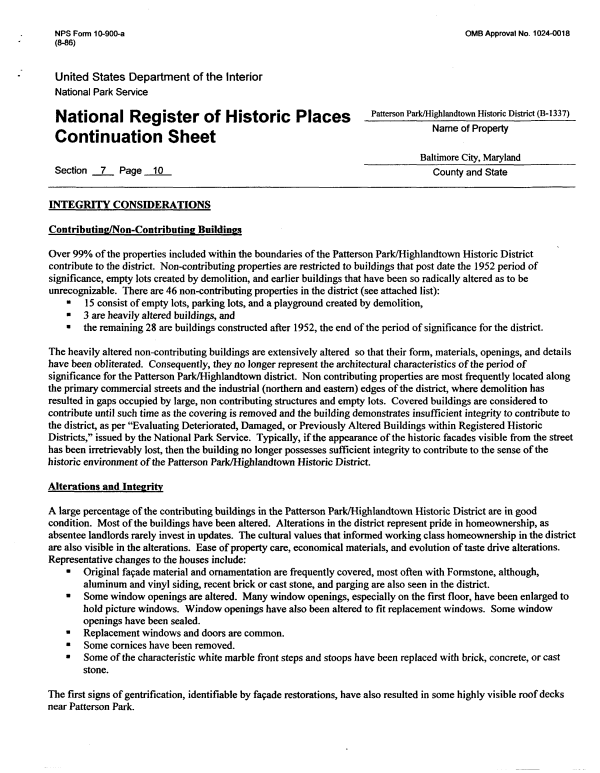 |
||||
|
DEPARTMENT OF HOUSING AND COMMUNITY DEVELOPMENT, MARYLAND HISTORICAL TRUST (Historic Sites Survey) var.d. MSA SE16-3 Image No: se16-3-0095 Enlarge and print image (77K) |
 |
||||
|
DEPARTMENT OF HOUSING AND COMMUNITY DEVELOPMENT, MARYLAND HISTORICAL TRUST (Historic Sites Survey) var.d. MSA SE16-3 Image No: se16-3-0095 Enlarge and print image (77K) |
| NFS Form 1 0-900-a OMB Approval No. 1 024-001 8 (8-86) United States Department of the Interior National Park Service pattern paA/Highiandtown Historic National Register of Historic Places -^ A. ,. r*§_ A Name of Property Continuation Sheet Baltimore City, Maryland Section 7 Page 10 County and State INTEGRITY CONSIDERATIONS Contributing/Non-Contributing Buildings Over 99% of the properties included within the boundaries of the Patterson Park/Highlandtown Historic District contribute to the district. Non-contributing properties are restricted to buildings that post date the 1952 period of significance, empty lots created by demolition, and earlier buildings that have been so radically altered as to be unrecognizable. There are 46 non-contributing properties in the district (see attached list): 15 consist of empty lots, parking lots, and a playground created by demolition, 3 are heavily altered buildings, and the remaining 28 are buildings constructed after 1952, the end of the period of significance for the district. The heavily altered non-contributing buildings are extensively altered so that their form, materials, openings, and details have been obliterated. Consequently, they no longer represent the architectural characteristics of the period of significance for the Patterson Park/Highlandtown district. Non contributing properties are most frequently located along the primary commercial streets and the industrial (northern and eastern) edges of the district, where demolition has resulted in gaps occupied by large, non contributing structures and empty lots. Covered buildings are considered to contribute until such time as the covering is removed and the building demonstrates insufficient integrity to contribute to the district, as per "Evaluating Deteriorated, Damaged, or Previously Altered Buildings within Registered Historic Districts," issued by the National Park Service. Typically, if the appearance of the historic facades visible from the street has been irretrievably lost, then the building no longer possesses sufficient integrity to contribute to the sense of the historic environment of the Patterson Park/Highlandtown Historic District. Alterations and Integrity A large percentage of the contributing buildings in the Patterson Park/Highlandtown Historic District are in good condition. Most of the buildings have been altered. Alterations in the district represent pride in homeownership, as absentee landlords rarely invest in updates. The cultural values that informed working class homeownership in the district are also visible in the alterations. Ease of property care, economical materials, and evolution of taste drive alterations. Representative changes to the houses include: Original fa9ade material and ornamentation are frequently covered, most often with Formstone, although, aluminum and vinyl siding, recent brick or cast stone, and parging are also seen in the district. Some window openings are altered. Many window openings, especially on the first floor, have been enlarged to hold picture windows. Window openings have also been altered to fit replacement windows. Some window openings have been sealed. Replacement windows and doors are common. Some cornices have been removed. Some of the characteristic white marble front steps and stoops have been replaced with brick, concrete, or cast stone. The first signs of gentrification, identifiable by fa£ade restorations, have also resulted in some highly visible roof decks near Patterson Park. |